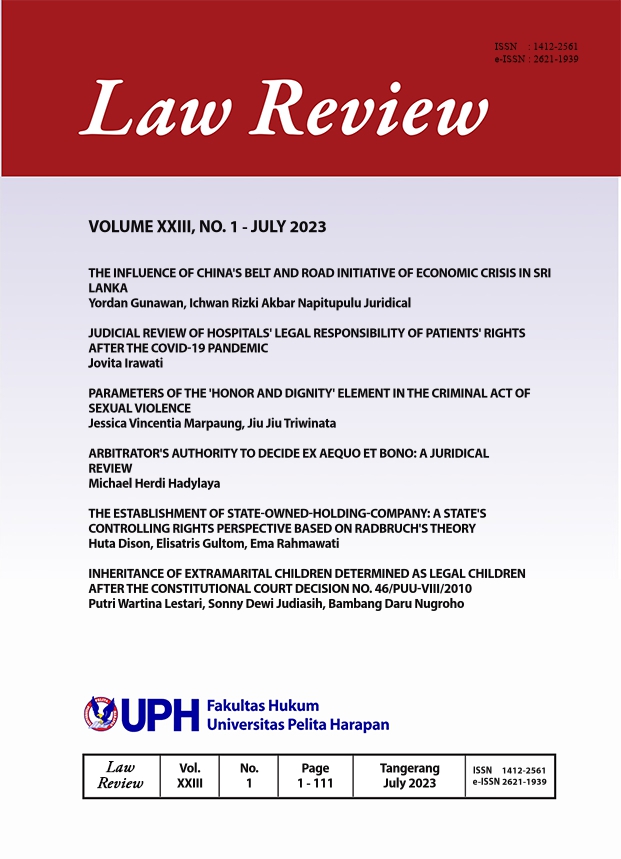The Influence of China’s Belt and Road Initiative of Economic Crisis in Sri Lanka
DOI:
https://doi.org/10.19166/lr.v23i1.6593Kata Kunci:
China’s Belt and Road Initiative, Sri Lanka, Debt Trap DiplomacyAbstrak
Sri Lanka, as a country in the South Asian region, is bordered by southeastern India and is in the southern Indian Ocean Sea region. This makes Sri Lanka a country with fast trade and maritime traffic, as well as a seaport. Bilateral connections have existed between Sri Lanka and China since the country's inception, and have been enhanced by financial and other aid supplied to the Sri Lankan government throughout the civil war against the separatist organization Liberation Tigers of Tamil Eelam (LTTE). Negotiations between Sri Lanka and China ended in 2017 with a deal for a Chinese-owned business, China Merchant Port Holdings Company Limited, to acquire almost 85% of Hambantota Port shares for 99 years. Because developed countries clearly have a more dominant role in the process of economic globalization, The research method used is normative law research with a case approach. The results show Sri Lanka's dependence on foreign investment to drive a country's economic growth. Therefore, this study aims to determine the legal arrangements governing the effects of the Belt and Road on the economic crisis in Sri Lanka from the perspective of international law and to determine the positive and negative impacts on the planned project.
Referensi
Journal Articles
Brautigam, Deborah. “A Critical Look at Chinese ”˜Debt-Trap Diplomacy’: The rise of a Meme.” Area Development and Policy 5, no.1 (2020): 1-14. https://doi.org/10.1080/23792949.2019.1689828.
Chan, Man Hung Thomas. “The Belt and Road Initiative - the New Silk Road: a Research Agenda.” Journal of Contemporary East Asia Studies 7, no. 2 (2019): 104-123. https://doi.org/10.1080/24761028.2019.1580407.
Chaudhury, Roy and Shantanu. “China, the Belt and Road Initiative, and the Hambantota Port Project.” St Antony's International Review 15, no. 1 (2019): 153-164. https://www.ingentaconnect.com/content/stair/stair/2019/00000015/00000001/art00010.
Horn, Sebastian, Bradley C. Parks, Carmen M. Reinhart & Christoph Trebesch. “China as an International Lender of Last Resort.” NBER Working Paper Series no. 31105 (April 2023). https://www.nber.org/papers/w31105.
Jain, Romi. “China’s Economic Expansion in South Asia: Strengths, Challenges and Opportunities.” Indian Journal of Asian Affairs 31, no. 1/2 (2018): 21-36. https://www.jstor.org/stable/26608821.
Jiang, Qinghan. “Debt Crisis and National Bankruptcy: Evidence from Sri Lanka.” BCP Business & Management 29, (2022): 315-321. https://doi.org/10.54691/bcpbm.v29i.2288.
Kamburawala, Tharindu Udayanga and Dilmini Hasintha Abeyrathne. “Belt and Road Initiative (BRI) and Sri Lanka: A Review of Literature.” KDU Journal of Multidisciplinary Studies 4, no. 2 (2022): 56-65. http://doi.org/10.4038/kjms.v4i2.51
Liang, Yan. “RMB Internationalization and Financing Belt-Road Initiative: an MMT Perspective.” The Chinese Economy 53, no. 4 (2020): 317-328. https://doi.org/10.1080/10971475.2020.1728478.
Peters, Michael A. “China’s Belt and Road Initiative: Reshaping Global Higher Education.” Educational Philosophy and Theory 52, no. 6 (2020): 586-592. https://doi.org/10.1080/00131857.2019.1615174.
Putera, I Gst Ngr Arya Permana, Idin Fasisaka, Anak Agung Ayu Intan Prameswari. “Kepentingan Tiongkok dalam Akuisisi Pelabuhan Hambantota Sri Lanka.” Diskusi Ilmiah Komunitas Hubungan Internasional 1, no. 1 (2019): 1-15. https://ojs.unud.ac.id/index.php/hi/article/view/47631.
Rivai, Aspin Nur Arifin. “Ambisi Ekspansi Bisnis dan Politik Strategis Cina di Asia Tenggara Melalui Belt Road Initiative: Tinjauan Diplomasi Infrastruktur.” Review of International Relations 4, no. 2 (2023): 188-219. https://doi.org/10.24252/rir.v4i2.35041.
Singh, Abhijit. “China’s ”˜Maritime Bases’ in the IOR: A Chronicle of Dominance Foretold.” Strategic Analysis 39, no. 3 (2015): 293-297. https://doi.org/10.1080/09700161.2015.1022320.
Sun, Degang and Yahia Zoubir. “”˜Development First’: China’s Investment in Seaport Constructions and Operations along the Maritime Silk Road.” Asian Journal of Middle Eastern and Islamic Studies 11, no. 3 (2017): 35-47. https://doi.org/10.1080/25765949.2017.12023308.
TroÅ¡ić, Sanja Jelisavac. “China's Accession to the World Trade Organization: the Process and the Effects.” Megatrend revija/Megatrend Review 16, no. 1 (2019): 173-192. http://megatrend.edu.rs/wp-content/uploads/2019/03/Megatrendrevija12019.pdf.
Wibisono, Adhe Nuansa. “China’s ”˜Belt and Road Initiative’ in Sri Lanka: Debt Diplomacy in Hambantota Port Investment.” Mandala: Jurnal Ilmu Hubungan Internasional 2, no.2 (2019): 222-245. https://doi.org/10.33822/mjihi.v2i2.1482.
Yu, Hong. “Reform of State-owned Enterprises in China: The Chinese Communist Party Strikes Back.” Asian Studies Review 43, no.2 (2019): 332-351. https://doi.org/10.1080/10357823.2019.1590313.
News or Magazine Articles
Hillman, Jonathan E. “How Big is China’s Belt Road?” Center for Strategic and International Studies, April 3, 2018. https://www.csis.org/analysis/how-big-chinas-belt-and-road.
Tan, Su-Lin. “Sri Lanka and IMF Reach Preliminary Deal on $2.9 Billion Loan.” CNBC, September 1, 2022. https://www.cnbc.com/2022/09/01/sri-lanka-and-imf-reach-preliminary-deal-on-2point9-billion-loan-.html.
Zuraya, Nidia. “China Pertimbangkan Beri Pinjaman Rp 36 Triliun untuk Sri Lanka.” Republika, March 22, 2022. https://ekonomi.republika.co.id/berita/r955x8383/china-pertimbangkan-beri-pinjaman-rp-36-triliun-untuk-sri-lanka.Unduhan
File Tambahan
Diterbitkan
Cara Mengutip
Terbitan
Bagian
Lisensi
Authors who publish with this journal agree to the following terms:
1) Authors retain copyright and grant the journal right of first publication with the work simultaneously licensed under a Creative Commons Attribution License (CC-BY-SA 4.0) that allows others to share the work with an acknowledgement of the work's authorship and initial publication in this journal.
2) Authors are able to enter into separate, additional contractual arrangements for the non-exclusive distribution of the journal's published version of the work (e.g., post it to an institutional repository or publish it in a book), with an acknowledgement of its initial publication in this journal.
3) Authors are permitted and encouraged to post their work online (e.g., in institutional repositories or on their website). The final published PDF should be used and bibliographic details that credit the publication in this journal should be included.





